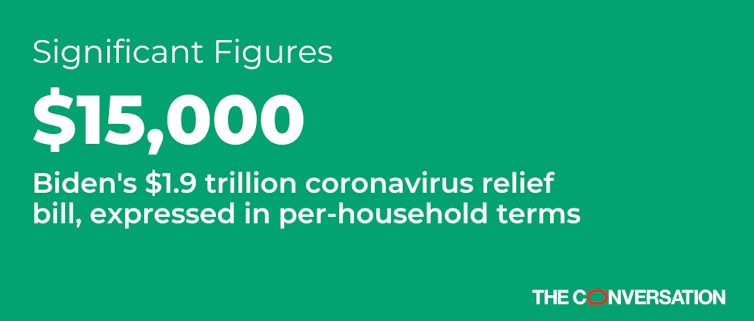Support for Biden's $1.9 trillion coronavirus relief package may not be as broad as it seems – it's
It's awfully hard to wrap your mind around a sum that large. But converting it to a more bite-size representation can affect a voter's willingness to support government spending.


Congress is on the verge of spending US$1.9 trillion to provide additional coronavirus relief to Americans, including $1,400 direct payments and extended unemployment benefits. Opinion polls show the bill has strong support, even among Republican voters.
But what if you were told that this spending level represents about $15,000 for every household in the U.S.? Would that make you less likely to support it even if you like its provisions?
We are accounting professors who research how the presentation of financial information affects individual judgments. Our recent work suggests it would lessen most people’s support for the spending bill.
Making sense of big numbers
In the Spring 2020 issue of Behavioral Research in Accounting, we published a study investigating whether individuals comprehend the large numbers involved in government spending.
The federal government routinely spends amounts in the millions, billions and, more recently, trillions, yet these numbers are far beyond what individuals encounter on a daily basis, making it hard for most people – and probably lawmakers – to wrap their heads around them.
We hypothesized that presenting the cost of government spending in per-household terms would make these amounts easier for individuals to understand and evaluate.
In our study, we conducted an experiment in which people evaluated a hypothetical federal spending proposal that included provisions like job training, unemployment benefits and infrastructure spending. Half the participants were presented with a plan that would cost $718 million, while the other half saw the same proposal at a cost of $718 billion. Participants were randomly told either the full cost of the proposal or the tally in per-household terms. That is, $5,744 for the $718 billion version and $5.74 for the $718 million one.
We found no difference in the level of support expressed by people who saw the $718 million proposal versus people who saw the $718 billion proposal, even though it’s 1,000 times larger. But the people who saw the per-household amount expressed significantly less support for the version with the larger price tag. Additionally, we then showed the participants who were given the total figures the per-household expression and found a similar drop in support for the more expensive proposal.
Thus, we concluded that the per-household presentation made individuals cost sensitive to government spending.
Interestingly, although liberals were on average more likely to support the spending proposal than conservatives, both groups became more cost sensitive when government spending was presented in per-household terms.
What it means
This is not to suggest the U.S. should or shouldn’t spend $1.9 trillion on coronavirus relief.
Our point is that it’s important to make these large numbers relatable to voters, allowing them to put the overall cost into context and then make up their own minds on whether the spending is worth it. And it may mean, were voters told the per-household cost of the $1.9 billion bill, they’d offer less support.
One caveat to this is that putting government spending in per-household terms may lead voters to incorrectly think they are personally responsible for that amount. Most – though not all – government funding comes from individual taxpayers, and not all households pay an equal share.
However, we also found that participants didn’t have increased cost sensitivity because they felt personally liable, but because they simply understood the magnitude of the spending better.
[Insight, in your inbox each day. You can get it with The Conversation’s email newsletter.]
The authors do not work for, consult, own shares in or receive funding from any company or organization that would benefit from this article, and have disclosed no relevant affiliations beyond their academic appointment.
Read These Next
The ‘one chatbot per child’ model for AI in classrooms conflicts with what research shows: Learning
AI tutors are often held up as an ideal, but prioritizing individualized teaching can detract from the…
Pardons are political, with modern presidents expanding their use
Trump and Biden have issued pardons at a faster clip than their predecessors. Many of their decisions…
Getting peace right: Why justice needs to be baked into ceasefire agreements – including Ukraine’s
Just war theory, a centuries-old field of ethics, deals with how and when to start conflicts. It can…






